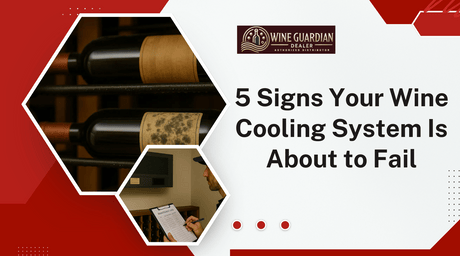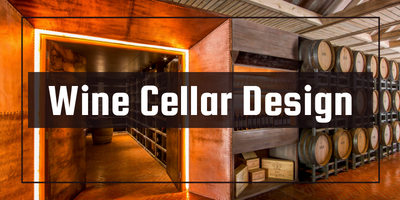
5 Signs Your Wine Cooling System Is About to Fail
Don’t wait for a costly surprise. Wine Guardian Dealer breaks down the top 5 signs your wine cooling system may be failing — and how to fix it before damage...
Jim Hopper
In Stock & Ready to Ship – Order Your Wine Cooling System Today!
Free Wine Cellar Expert Consultation | 📞 Call 1-800-260-1712
Start with a free expert consult—cooling system sizing, racking options, and no upsells.

Build your dream wine cellar—without costly mistakes or guesswork.
By Jim Hopper, Wine Cooling Expert
Aging wine is an art that requires precision, patience, and the right storage conditions. Whether you're a seasoned collector or a budding enthusiast, ensuring your wine matures under optimal conditions is essential.
A wine cabinet for proper wine aging is a crucial investment that helps maintain temperature, humidity, and protection against external elements — preserving the flavors and value of your wine collection for years to come.
For expert strategies on long-term wine storage and equipment selection, explore our full Wine Aging and Preservation: Protecting Your Collection for the Next 30 Years.
A wine cabinet is a specialized storage unit designed to create and maintain the ideal conditions for wine aging. Unlike a wine fridge or traditional wine cellar, a wine cabinet with wine cooler is equipped with features that regulate temperature, humidity, and light exposure while minimizing vibrations.

|
Feature |
Wine Cabinet |
Wine Cellar |
|
|---|---|---|---|
|
Temperature Control |
✅ Stable |
⚠️ Can fluctuate, making it hard to maintain stable temperatures |
✅Stable |
|
Humidity Control |
✅ Yes |
❌ No |
✅ Yes |
|
UV Protection |
✅ Yes |
❌ Limited |
✅ Yes |
|
Vibration-free Storage |
✅ Yes |
❌ No |
✅ Yes |
|
Best for Aging Wines |
✅ Yes |
❌ No |
✅ Yes |
Aging wine under poor conditions can lead to oxidation, spoilage, or loss of aroma and flavor. Storing wine at near freezing temperatures can also negatively impact the aging process by causing precipitation in the bottle and slowing down essential chemical reactions. The right wine cabinet cooler provides a controlled environment, protecting your bottles from:
Temperature fluctuations that accelerate aging.
Excess humidity that can damage corks and labels.
Light exposure that breaks down compounds in wine.
Vibration that disturbs sediment and alters flavor.

A wine cabinet cooling unit maintains a consistent temperature, preventing fluctuations that can degrade wine quality. Storing wine at temperatures that are warmer than the ideal range can accelerate the aging process, making it crucial to maintain a stable and cooler environment.
With 50-70% humidity, a wine cabinet prevents corks from drying out and allows wines to mature naturally. Stable humidity levels ensure that the wine is protected, maintaining its quality and preventing detrimental effects from fluctuations.
Wine is sensitive to direct sunlight, which can break down essential compounds. Most wine cabinets are built with UV-resistant glass doors to shield against harmful rays.
It's important to take note of your wine's condition regularly to avoid spoilage due to light exposure.
Minimal movement ensures that wine sediment settles naturally, allowing for better taste development over time.
Additionally, vibrations can cause wines to lose their quality over time.
Wine cabinets prevent mold and odors by incorporating carbon filters and ventilation systems that keep air circulation optimal.
Maintaining optimal conditions in a home wine cellar is crucial to prevent mold and odors, as home storage methods can be more prone to issues like temperature fluctuations and security risks.
Freestanding: Ideal for flexibility in placement, offering large storage capacity.
Built-in: Designed to fit seamlessly into kitchen or bar spaces, requiring proper ventilation.
Single-zone cabinets maintain a consistent temperature, which is crucial to properly store wine and is best for aging red or white wines.
Dual-zone cabinets allow separate temperature settings, providing the ideal conditions to store wine, making them perfect for storing both reds and whites.
For those looking for a more personalized touch, a DIY wine cabinet can be a cost-effective alternative. While it may not offer the temperature stability of a professional wine cabinet cooling unit, it can be customized to fit any space.
The vast majority of wines available today are ready-to-drink and not intended for long-term aging, making proper storage conditions essential for maintaining their quality.

Preserves wine’s resale value for collectors and investors.
Ensures peak taste development for fine wines.
Showcases your collection in an aesthetically appealing display.
Storing wine at the wrong temperature.
Overcrowding bottles, which affects airflow and aging conditions.
Ignoring humidity levels, leading to cork deterioration and oxidation.
Maintaining the proper storage conditions can be hard, as achieving temperature stability is one of the hardest aspects of wine storage.
If you’re looking for top-quality wine cabinets that offer superior temperature control, humidity regulation, and long-term wine aging storage solutions, look no further than Wine Guardian Dealer. As an authorized Wine Guardian dealer, we provide the best wine storage solutions designed to protect and enhance your valuable wine collection.
At Wine Guardian Dealer, we offer:
Premium wine cabinets with cutting-edge technology.
Expert guidance and advice to help you choose the right storage solution for your collection.
Reliable customer service to ensure your complete satisfaction.
Wine cabinets are designed for long-term storage, but for opened bottles, consider vacuum sealers or wine preservation systems. Proper storage is crucial to ensure that opened bottles do not lose their quality over time.
Red wine: 55°F–65°F
White wine: 45°F–55°F
Sparkling wine: 40°F–50°F
Storing wine at warmer temperatures can accelerate the aging process, potentially leading to imbalanced flavors and aromas.
Properly stored wine can last years or even decades, depending on the varietal and storage conditions.
It is important to take note of your wine's condition over time to ensure it remains in optimal condition.
A wine cabinet is more than just a storage unit—it is an investment in preserving and enhancing the quality of your wine. Whether you’re a casual collector or a serious enthusiast, the right wine cabinet ensures every bottle reaches its full potential.
Maintaining optimal conditions in a home wine cellar is crucial to ensure the quality of your wine.
Wine cabinets are designed for long-term storage, but for opened bottles, consider vacuum sealers or wine preservation systems. Proper storage is crucial to ensure that opened bottles do not lose their quality over time.
Red wine: 55°F–65°F White wine: 45°F–55°F Sparkling wine: 40°F–50°F Storing wine at warmer temperatures can accelerate the aging process, potentially leading to imbalanced flavors and aromas.
Properly stored wine can last years or even decades, depending on the varietal and storage conditions. It is important to take note of your wine's condition over time to ensure it remains in optimal condition.
🛒Shop our most-loved Wine Guardian cooling systems today.
🛠️Protect your wine with the most trusted systems on the market.
❤️Tested, reviewed, and loved by serious collectors like you.